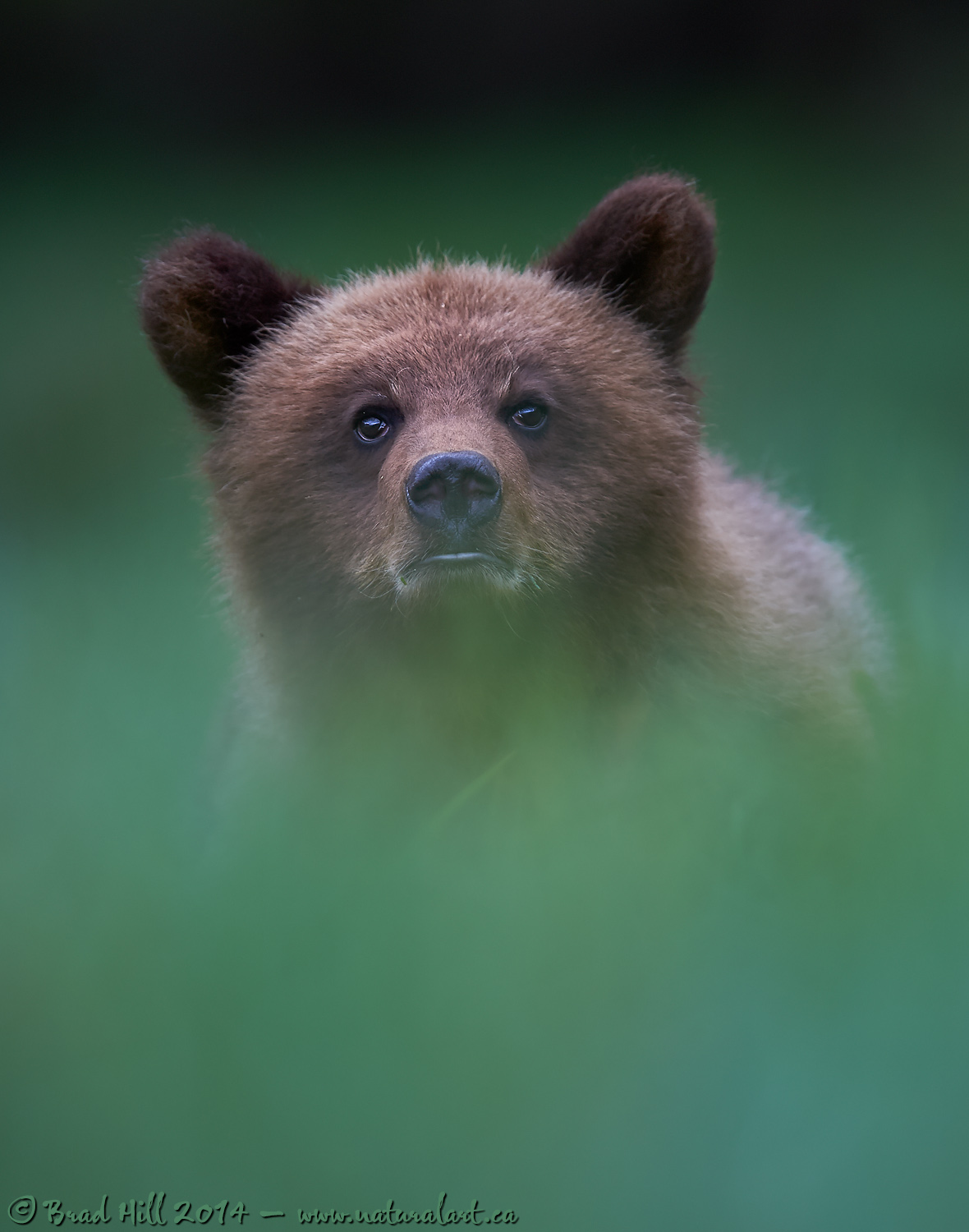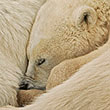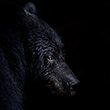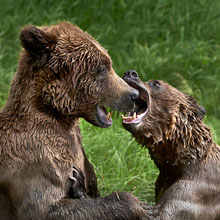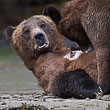Availability: Undetermined - Enquiries?
In the Field
Inquisitive. Khutzeymateen Grizzly Sanctuary, northern BC coast, Canada. May 29, 2014.
From what I've seen, all young animals - including humans - have a high degree of innate curiosity. Which makes sense - ultimately there's value in understanding their environment - what is good and can be approached, what is bad and should be avoided, and so on.
Bear cubs are no exception to this rule. Their initial reaction to a novel object or stimulus is often fear - and this is most often expressed by them scurrying off or clambering up a tree. But cubs take their cues off mom - and if mom doesn't follow suit and run off the cubs will often slowly return and show extreme interest in the object that initially scared them. And that's exactly what was going on here - a yearly grizzly cub couldn't resist checking out a weird gray floating object (with several upright moving appendages, each with a single HUGE eye looking at it!) that mom seemed to be cool with! Supreme curiosity. Pure inquisitiveness! And that's what I hoped to convey with this shot - as the cub came directly at me with all sensory devices (nose, eyes, ears) engaged!
I shot this image directly through long grass that was quite close to me (much closer to me than it was to the cub). In this shot the grass was, of course, thickest at the bottom of the frame, but it extended up to about halfway up the cub's nose. Its snout - and everything at and above its eyes - were clear of the grass I was shooting through. I have to admit I was pretty excited at the time - I was quite sure that given the arrangement of all the elements in the shot (proximity of foreground grass, distance to background and to the cub) if I shot at a very wide aperture virtually all the grass would be thrown out of completely out-of-focus and rendered dreamy soft. So...I cranked the aperture ALMOST wide open and waited until the cub gave me a long, hard, look and fired away. Why didn't I just open up the aperture ALL the way? While the lens I shot this with (i.e., the 400mm f2.8 VR) is among the best in Nikon's lineup, you still have to stop down just a tad before you attain maximal image sharpness. So it was f3.2 rather than f2.8.
One further comment on this shot. I captured this shot not too long after completing my field test of the AF-S 80-400mm f4.5-5.6 VR zoom lens (which was right beside me when I shot this). My review of that lens was very positive - and I still think the new 80-400 is a fantastic lens. In my final paragraph of that review I said "Owning it won't motivate me to sell my 400mm f2.8 VR prime...". That single comment has generated a LOT of emails - most of which more-or-less said "if you like the 80-400 so much, why keep your 400mm f2.8 VR?" Well, despite the major "pain-in-the-ass factor" that the weight and size of the 400mm f2.8 VR bestows on the user, I'll say this: just look at this image!! For me owning and using the 400mm f2.8 VR is well worth "enduring" the pain-in-the-ass factor!
Here's a higher resolution (2400 pixel) version of the image for your perusal (enjoy!):
• Inquisitive: Download 2400 pixel image (JPEG: 1.3 MB)
NOTES:
1. This image - in all resolutions - is protected by copyright. I'm fine with personal uses of it (including use as desktop backgrounds or screensavers on your own computer), but unauthorized commercial use of the image is prohibited by law. Thanks in advance for respecting my copyright!
2. Like all wildlife photographs on this website, this image was captured following the strict ethical guidelines described in The Wildlife FIRST! Principles of Photographer Conduct. I encourage all wildlife photographers to always put the welfare of their subjects above the value of their photographs.
3. This image was captured during one of my "Grizzlies of the Khutzeymateen" photo tour in the spring of 2014. Each year I offer trips into two different parts of the Great Bear Rainforest as well as one to photograph aquatic mammals and oceanscapes near the northern tip of Vancouver Island. And, in selected years, I also offer photo tours to locations to capture other highly sought-after subjects, such as various boreal owl species and wildlife of Canada's Arctic. Details about these trips can be found on the Photo Tours page of this website.
Behind the Camera
Inquisitive. Khutzeymateen Grizzly Sanctuary, northern BC coast, Canada. May 29, 2014.
Digital Capture; Compressed RAW (NEF) 14-bit format; ISO 200.
Nikon D4s paired with Nikkor AF-S 400mm f2.8 VR - hand-held from floating Zodiac. VR on in Normal mode.
1/500s @ f3.2; -0.67 stop compensation from "recommended" matrix-metered exposure setting.
At the Computer
Inquisitive. Khutzeymateen Grizzly Sanctuary, northern BC coast, Canada. May 29, 2014.
RAW Conversion to 16-bit TIFF, including first-pass/capture sharpening using Phase One's Capture One Pro.
Image resizing and output sharpening performed using Photoshop CC. No further post-processing performed on the image. Once in a blue moon all the planets align and camera, lens, and user settings combine so what you end up with right out of the camera is exactly the way the scene appeared through the viewfinder. This was one of those times!
Conservation
Inquisitive. Khutzeymateen Grizzly Sanctuary, northern BC coast, Canada. May 29, 2014.
Ten percent of the revenue generated by this image will be donated to Raincoast*.
Species Status in Canada**: Special Concern (May 2002).
While Grizzly Bears (Ursus arctos) are not technically listed as "Endangered" in Canada, they have been extirpated from most of their historical range. Grizzly Bears are far more sensitive to intrusion/disturbance in their habitat than are Black Bears and are being increasingly forced into marginal habitat by human encroachment. The Great Bear Rainforest along the central and northern coast of British Columbia is one of the last strongholds of the Grizzly Bear in Canada, and even this population is coming under increasing pressure.
On December 18, 2017 the government of British Columbia banned grizzly hunting across the entire province. This major conservation victory came after decades of tireless work by many dedicated conservationists and ecologists and, most importantly, it reflects the opinion of the vast majority of British Columbians. And, it means that AT LEAST while the current government remains in power grizzlies are finally "safe" in British Columbia.
Now that we've at least temporarily won the battle to save grizzlies in BC, it's time to re-focus our efforts toward protecting ALL of BC's carnivores, including Gray Wolves, Black Bears, Cougars, Wolverines, and more! Simply put, there are no ecological, economic, or ethical arguments supporting the trophy hunting of carnivores.
In a great first step towards ending the hunting of carnivores throughout BC the Raincoast Conservation Foundation has developed a program designed to protect ALL carnivores within the Great Bear Rainforest. Details about this program can be found on this page on Raincoast's website. Check it out and, better yet, make a donation to help Raincoast purchase the remaining commercial hunting tenures in the Great Bear!
*The Raincoast Conservation Society (and Foundation) is an effective and efficient organization that has been fighting for protection of this unique habitat. If you are looking for a meaningful way to contribute to the conservation of this amazing ecosystem, Raincoast will provide maximal "bang" for your conservation dollars.
**as determined by COSEWIC: The Committee on the Status of Endangered Wildlife in Canada












